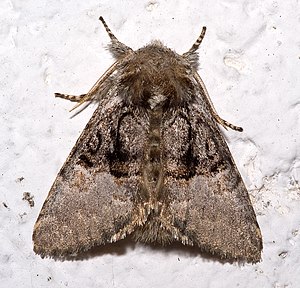Hazel owl
| Hazel owl | ||||||||||||
|---|---|---|---|---|---|---|---|---|---|---|---|---|

Hazel Owl ( Colocasia coryli ) (light specimen) |
||||||||||||
| Systematics | ||||||||||||
|
||||||||||||
| Scientific name | ||||||||||||
| Colocasia coryli | ||||||||||||
| ( Linnaeus , 1758) |
The hazel owl ( Colocasia coryli ) is a butterfly ( moth ) from the subfamily of the Pantheinae within the owl butterflies (Noctuidae).
features
The moths reach a wingspan of 32 to 36 millimeters. The head is gray, the thorax dark gray and the abdomen dark gray. The antennae are bipectinate (double-combed) in the males and filiform (thread-like) in the females. The forewings are dark brown in the basal half and light gray in the outer half, sharply demarcated. The basal half can also be light colored; such forms were previously called forma avellanae Huene, 1901. Regionally, this aberration can be more common than the normal form. The black cross lines are wavy or serrated. The kidney defect is barely developed, black, and fused with the outer transverse line. In contrast, the elliptical ring blemish is bordered in black with a small central black spot. The hind wings are gray and get a little darker towards the outer edge. The discal patch is hardly developed. The underside of the fore and hind wings is light gray with an indistinct outer transverse line and an indistinct wavy line. The discal patches are also poorly developed.
The egg is cone-shaped with a flattened base. It is white with a red band on the top. The surface is covered with numerous, strong longitudinal ribs.
The caterpillars are about 35 millimeters long. They are very variable light brown, whitish or reddish in color and have a broad black back line. On the second segment they have two reddish brown or black tufts of hair facing forward, on the fourth, fifth and eleventh segments there are also such, only slightly smaller hair brushes.
The squat doll is shiny light red-brown to dark red-brown with a conical cremaster rounded at the end and bearing strong, curved bristles. The surface of the Kremaster is peculiarly wrinkled.
Geographical distribution and habitat
The hazel owl is found in almost all of Europe and western Asia. In the north the distribution area extends to northern Scandinavia , in the south the distribution limit extends over montane layers of western and northern Spain , Sicily , Greece and Asia Minor . In the east, the distribution area reaches Lake Baikal . The animals can be found in deciduous forests , bush landscapes and parks . They are common and common. In the Alps , the species rises up to 1600 m.
Way of life
As a rule, the hazel owl forms two generations per year. The moths fly from April to June and from July to September. In cooler areas and in the north, only one generation is formed whose moths fly from May to June.
The young caterpillars spin leaves together and hide in between, the older animals sit on the underside of the leaves. The caterpillars feed on the leaves of various deciduous trees . They are mainly found on hornbeam ( Carpinus betulus ), common hazel ( Corylus avellana ), common beech ( Fagus sylvatica ) and common oak ( Quercus robur ), but also on other species of the genera birch ( Betula ), oak ( Quercus ), beech ( Fagus ), alders ( Alnus ), poplars ( Populus ), willows ( Salix ), apples ( Malus ), prunus , hawthorn ( Crataegus ), maples ( Acer ) and ash trees ( Fraxinus ).
Pupation takes place in a light, bright web. The species overwinters as a pupa, the moths hatch in spring.
swell
Individual evidence
- ↑ a b Fibiger et al. (2009: p. 23/4).
- ↑ Manfred Koch : We identify butterflies. Volume 3: Owls. 2nd, expanded edition. Neumann, Leipzig / Radebeul 1972, DNB 760072930 .
- ↑ a b c d e Heiko Bellmann : The new cosmos butterfly guide. Butterflies, caterpillars and forage plants. Franckh-Kosmos, Stuttgart 2003, ISBN 3-440-09330-1 , p. 280.
- ↑ Günter Ebert (Ed.): The Butterflies of Baden-Württemberg Volume 5, Moths III (Sesiidae, Arctiidae, Noctuidae). Ulmer Verlag Stuttgart 1997. ISBN 3-800-13481-0
- ↑ Walter Forster , Theodor A. Wohlfahrt : The butterflies of Central Europe. Volume 4: Owls. (Noctuidae). Franckh'sche Verlagshandlung, Stuttgart 1971, ISBN 3-440-03752-5 .
literature
- Michael Fibiger, László Ronkay, Axel Steiner & Alberto Zilli: Noctuidae Europaeae Volume 11 Pantheinae, Dilobinae, Acronictinae, Eustrotiinae, Nolinae, Bagisarinae, Acontiinae, Metoponiinae, Heliothinae and Bryophilinae. 504 pp., Entomological Press, Sorø 2009 ISBN 978-87-89430-14-0
Web links
- www.lepiforum.de
- Moths and Butterflies of Europe and North Africa (English)
- Ian Kimber: Guide to the moths of Great Britain and Ireland (English)
- www.schmetterling-raupe.de
- Colocasia coryli at Fauna Europaea

